History
The evolution of AST from the beginnings until present.
Today
- 2022AST, Elering, Litgrid and PSE, the electricity transmission system operators (TSOs) of the Baltic countries and Poland, signed the grant agreement with the European Climate, Infrastructure and Environment Executive Agency (CINEA) for EUR 170 million of EU support which will help to finance the planned investments under the project Phase 2 part II of the Baltic Synchronization.
 2021AS Augstsprieguma tīkls successfully debuted in the capital market, implementing the placement of green bonds in the amount of 100 million euros. With this bond issue, AST becomes the first Baltic transmission system operator to issue green bonds. In the re - evaluation process, International credit rating agency S&P Global Ratings granted to the Latvian transmission system operator AS Augstsprieguma tīkls long-term credit rating A-. AS Augstsprieguma tīkls has been ranked as the third most valuable among the state capital companies in the initiative “TOP101 of the Most Valuable Companies in Latvia”, but it ranks 7th among all Latvian companies included in the top.
2021AS Augstsprieguma tīkls successfully debuted in the capital market, implementing the placement of green bonds in the amount of 100 million euros. With this bond issue, AST becomes the first Baltic transmission system operator to issue green bonds. In the re - evaluation process, International credit rating agency S&P Global Ratings granted to the Latvian transmission system operator AS Augstsprieguma tīkls long-term credit rating A-. AS Augstsprieguma tīkls has been ranked as the third most valuable among the state capital companies in the initiative “TOP101 of the Most Valuable Companies in Latvia”, but it ranks 7th among all Latvian companies included in the top.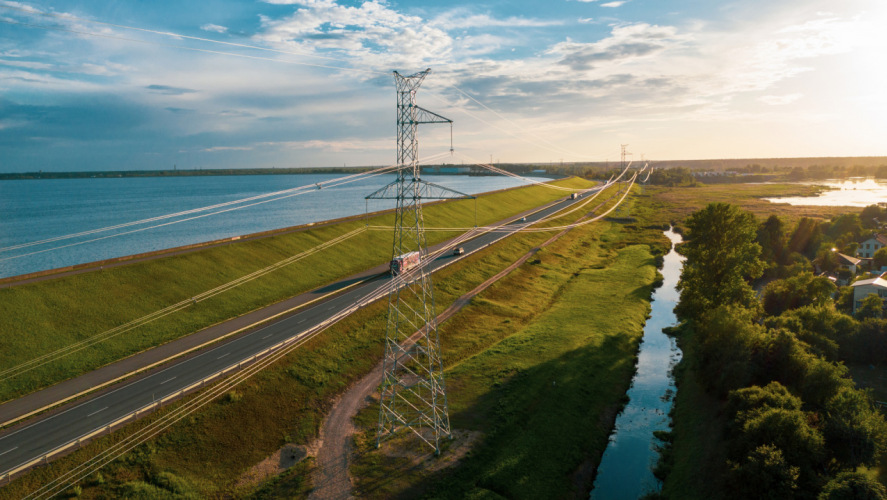 2020The reform of the ownership of the transmission system assets has been completed by merging the owner of the transmission assets AS Latvijas elektriskie tīkli with AS Augstsprieguma tīkls. AS Augstsprieguma tīkls took over all assets and liabilities of AS Latvijas elektriskie tīkli. Decisive influence in AS Conexus Baltic Grid gained: AS Augstsprieguma tīkls increased its control in the company to 68.46% fulfilling the task given by the Cabinet of Ministers. The projects “Construction of the Power Transmission Line “Riga CHP-2 – Riga HPP”” and "Third Estonia-Latvia 330 kV interconnection” has been completed. For the first time, the international credit rating agency S&P Global Ratings has assessed and assigned the long-term credit rating BBB+ to the Latvian transmission system operator AS Augstsprieguma tīkls. The issuance of European standard guarantees of origin for electricity has started: AS Augstsprieguma tīkls has joined the unified European Energy Certificate System. AST issues certificates of origin of electricity, which serve as proof that the electricity is produced from renewable energy or by using efficient cogeneration.
2020The reform of the ownership of the transmission system assets has been completed by merging the owner of the transmission assets AS Latvijas elektriskie tīkli with AS Augstsprieguma tīkls. AS Augstsprieguma tīkls took over all assets and liabilities of AS Latvijas elektriskie tīkli. Decisive influence in AS Conexus Baltic Grid gained: AS Augstsprieguma tīkls increased its control in the company to 68.46% fulfilling the task given by the Cabinet of Ministers. The projects “Construction of the Power Transmission Line “Riga CHP-2 – Riga HPP”” and "Third Estonia-Latvia 330 kV interconnection” has been completed. For the first time, the international credit rating agency S&P Global Ratings has assessed and assigned the long-term credit rating BBB+ to the Latvian transmission system operator AS Augstsprieguma tīkls. The issuance of European standard guarantees of origin for electricity has started: AS Augstsprieguma tīkls has joined the unified European Energy Certificate System. AST issues certificates of origin of electricity, which serve as proof that the electricity is produced from renewable energy or by using efficient cogeneration.- 2019The construction of 330 kV electric lines, "Third Estonia - Latvia interconnection" and "Riga CHP-2 – Riga HPP" has been commenced, and the electricity transmission network strengthening project "Kurzeme ring" has been completed. The Cabinet of Ministers has approved the progress towards the synchronisation of Latvia's electricity network with the European electricity system in 2025, as well as an agreement has been concluded on the accession of the Baltic states to the synchronous zone of European electricity networks. A new substation has been built in Skrunda. The Cabinet of Ministers has supported the transfer of ownership of the transmission system asset to AST.
 2018"The Kurzeme ring" electric line is under construction, and new 330 kV electric lines, "Third Estonia - Latvia interconnection" and "Riga CHP-2—Riga HPP", are in development. A new 110 kV Skrunda substation is built. Technical scenario for Baltic power grids synchronisation with the Continental European system approved in Brussels
2018"The Kurzeme ring" electric line is under construction, and new 330 kV electric lines, "Third Estonia - Latvia interconnection" and "Riga CHP-2—Riga HPP", are in development. A new 110 kV Skrunda substation is built. Technical scenario for Baltic power grids synchronisation with the Continental European system approved in Brussels- 2017330 kV power transmission line Riga CHP-2 - Riga HPP (Estonia - Latvia third interconnection internal network reinforcement in the territory of Latvia) is granted 50% co-funding from the European Union. Total co-funding granted amounts to EUR 9.9 million. Construction of Stage 3 of the power line Kurzeme Ring Ventspils – Tume – Riga is started. Status of the object of national interest determined for the newly constructed Riga CHP-2 - Riga HPP power transmission line. JSC Augstsprieguma tīkls wins a silver prize in the Sustainability Index for the second year in a row.
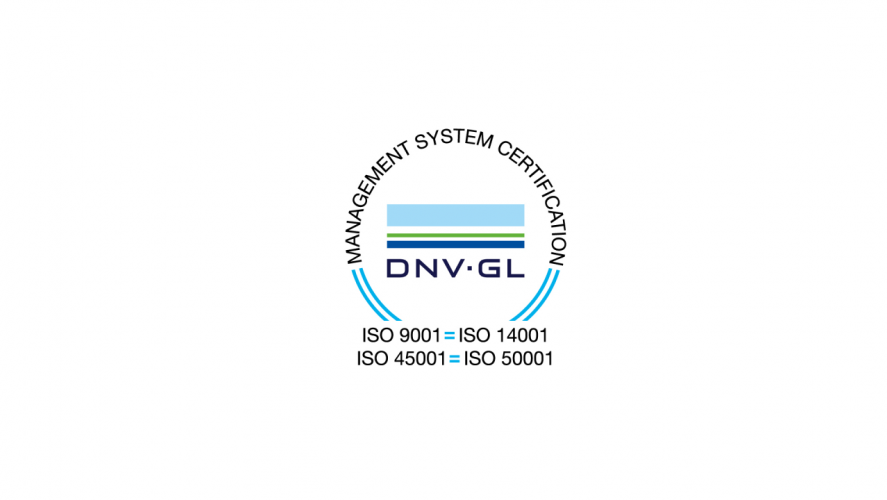 2016JSC Augstsprieguma tīkls wins a silver nomination in the Sustainability Index and is recognised as a Sustainability Champion by demonstrating the fastest growth in all of the criteria of the Sustainability Index. JSC Augstsprieguma tīkls introduces an energy management system according to the requirements of ISO 50001:2011 as one of the first companies in Latvia. Cabinet of Ministers approves the locations of the Latvia and Estonia high voltage line. Status of the object of national interest determined for the Estonia - Latvia third 330 kV interconnection. Kurzeme Ring project continued: completed increase of transfer capacity in the substations Tukums, Dzintari, Sloka and Ķemeri; development of the construction project for the reconstruction of 110 kV switchboards in the substations Priedaine and Valdemārpils started. A 110 kV transformer and auto-transformer reserve area in the substation Valmiera has been constructed.
2016JSC Augstsprieguma tīkls wins a silver nomination in the Sustainability Index and is recognised as a Sustainability Champion by demonstrating the fastest growth in all of the criteria of the Sustainability Index. JSC Augstsprieguma tīkls introduces an energy management system according to the requirements of ISO 50001:2011 as one of the first companies in Latvia. Cabinet of Ministers approves the locations of the Latvia and Estonia high voltage line. Status of the object of national interest determined for the Estonia - Latvia third 330 kV interconnection. Kurzeme Ring project continued: completed increase of transfer capacity in the substations Tukums, Dzintari, Sloka and Ķemeri; development of the construction project for the reconstruction of 110 kV switchboards in the substations Priedaine and Valdemārpils started. A 110 kV transformer and auto-transformer reserve area in the substation Valmiera has been constructed.- 2015JSC Augstsprieguma tīkls takes over the transmission system operation and maintenance functions as well as the transmission system development, construction of new networks, reconstruction and renewal of the existing networks from JSC Latvijas elektriskie tīkli. Power transmission system operators of the Baltic countries and Finland sign an agreement regarding the conditions for formation of the Baltic and Nordic country electricity balancing market. JSC Augstsprieguma tīkls, together with the Estonian transmission system operator Elering AS, starts organising capacity auctions (PTR-limited) on the border of Estonia and Latvia in the direction Estonia - Latvia. The new 330 kV power transmission line Grobiņa – Ventspils of the transmission project Kurzeme Ring solemnly switched on in the 330 kV substation Ventspils, connecting the reconstructed 330 kV substation Grobiņa with the newly built 330 kV substation Ventspils. Environmental impact assessment procedure started for arranging the Estonia - Latvia third interconnection. Transmission system operators of the Baltic countries develop an action plan for activities towards starting synchronous work with energy systems of continental Europe by 2025.
- 2013Public Utilities Commission approves JSC Augstsprieguma tīkls as an independent transmission system operator. Trade area of Latvia opened in the Baltic electricity market. NordPool next day electricity market ELSPOT starts operating in Latvia. JSC Augstsprieguma tīkls acquires 2% of shares in NordPool.
- 2012Ministry of Finance of the Republic of Latvia becomes a holder of shares of JSC Augstsprieguma tīkls. Construction of transmission connection of the Kurzeme Ring Stage 2 Grobiņa – Ventspils started. 110 kV cable line Milgrāvis – Bolderāja commissioned.
- 2011The Parliament adopts amendments to the Electricity Market Law by including the order for establishing an independent transmission system operator. JSC Augstsprieguma tīkls becomes an independent system operator.
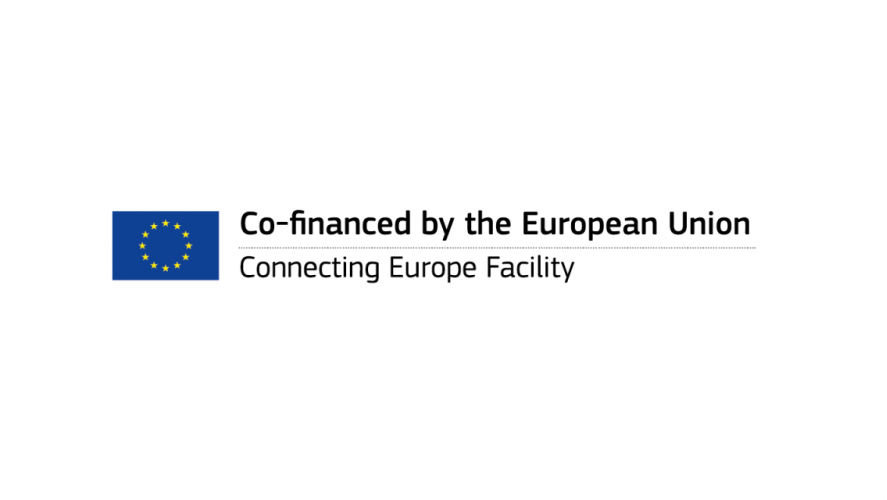 2010European Commission decides to financially support the construction of power transmission infrastructure in Latvia by granting co-funding for the project Kurzeme Ring. Funds granted within the general Nord Balt project envisaging the development of power lines and interconnections in the Baltics. Kurzeme Ring is the first transmission system infrastructure project started in the renewed Republic of Latvia and it will improve the power supply and its stability in Kurzeme.
2010European Commission decides to financially support the construction of power transmission infrastructure in Latvia by granting co-funding for the project Kurzeme Ring. Funds granted within the general Nord Balt project envisaging the development of power lines and interconnections in the Baltics. Kurzeme Ring is the first transmission system infrastructure project started in the renewed Republic of Latvia and it will improve the power supply and its stability in Kurzeme.- 2009Prime Ministers of the Baltic countries and President of the European Commission sign the strategic development document of the Baltic countries Baltic Energy Market Interconnection Plan (BEMIP) envisaging connecting energy systems of the Baltic countries with the European energy systems and opening a joint electricity market based on the principles of the Scandinavian electricity market. JSC Augstsprieguma tīkls becomes a full member of the European Transmission System Operators' Association Entso-E. Entso-E includes 41 transmission system operators from 34 European Union countries.
- 2008Reconstruction of 110 kV substations Riga CHP-2 and Aizkraukle completed. New 330 kV substation Riga CHP-2 commissioned. Agreement signed together with transmission system operators of the Baltic countries about the formation of the Latvia, Lithuania and Estonia cooperation organisation BALTSO and liquidation of DC Baltija. JSC Augstsprieguma tīkls took over the functions of the Baltic Dispatcher Centre. JSC Augstsprieguma tīkls, OÜ Põhivõrk and AS Lietuvos Energija sign an agreement regarding providing for parallel work on energy systems in the Baltic countries.
- 2007Latvia opens a free electricity market to all electricity users.
 2005JSC Augstsprieguma tīkls becomes a Joint Stock Company and acquires a licence from the Public Utilities Commission for power transmission in the entire territory of Latvia. JSC Augstsprieguma tīkls becomes an associated member of the European Transmission System Operators' Association ETSO. 6 December JSC Augstsprieguma tīkls becomes a co-owner of DC Baltija (instead of Latvenergo) holding a share of 33.33%. Instead of SE Eesti Energia, OÜ Põhivõrk became a co-owner of DC Baltija with a share of 33.33%, the holder of the remaining 33.33% remained as AS Lietuvos Energija.
2005JSC Augstsprieguma tīkls becomes a Joint Stock Company and acquires a licence from the Public Utilities Commission for power transmission in the entire territory of Latvia. JSC Augstsprieguma tīkls becomes an associated member of the European Transmission System Operators' Association ETSO. 6 December JSC Augstsprieguma tīkls becomes a co-owner of DC Baltija (instead of Latvenergo) holding a share of 33.33%. Instead of SE Eesti Energia, OÜ Põhivõrk became a co-owner of DC Baltija with a share of 33.33%, the holder of the remaining 33.33% remained as AS Lietuvos Energija.- 2002Creation of a reliable power supply scheme in Ventspils completed by constructing two new substations, Venta and Ventamonjaks, as well as closing the 110 kV power transmission ring around Ventspils City.
- 2001Energy systems of Belarus, Russia, Estonia, Latvia and Lithuania (BRELL) sign an agreement regarding ensuring parallel operation and operational management and development of the transmission network. Reconstruction of the 110 kV substation Riga CHP-1 completed.
- 2000Reconstruction of the 330 kV substation in Riga CHP-1 and 110 kV substation Pļaviņas and Aizkraukle completed.
- 1999JSC Augstsprieguma tīkls adopts the 330 kV and 110 kV network and substation development and reconstruction concept paper. 110 kV substations Dzintari, Grīziņkalns and Bauska reconstructed. 110 kV cable lines Grīziņkalns – Hanza in Riga and Ventspils – Venta in Ventspils constructed.
- 199817 energy companies from eleven countries of the Baltic Sea Region agree on establishment of the association Baltic Ring Electricity Cooperation (BALTREL) with a purpose to cooperate in electricity production, transmission, distribution and trade.
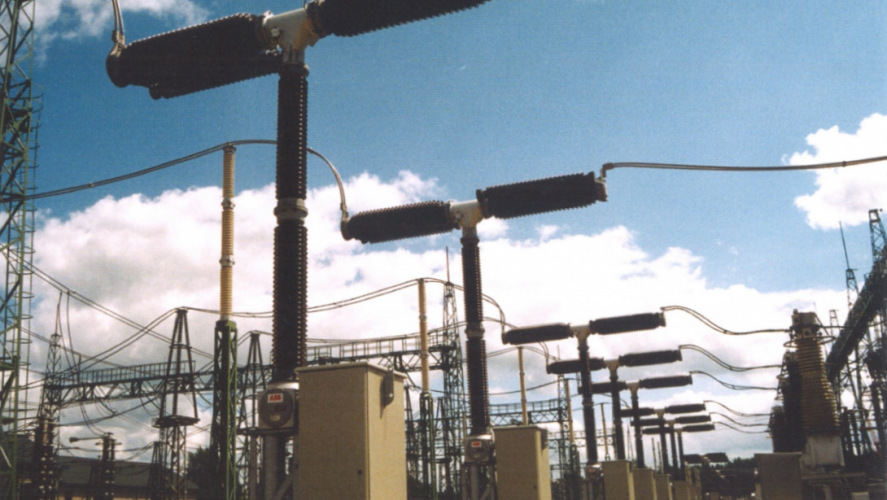 1997Substations Sloka, Ropaži, Salaspils and 110 kV cable line Vairogs – Andrejsala reconstructed.
1997Substations Sloka, Ropaži, Salaspils and 110 kV cable line Vairogs – Andrejsala reconstructed.- 1992Baltic governmental representatives sign an agreement in Riga regarding the parallel operation of energy systems. The Baltic Energy System Dispatchers Centre established, which provides for management and coordination of parallel operation of Baltic energy systems as well as operational management of the transmission network.
- 1991With the Baltic countries regaining independence, Baltic energy system withdraws from subordination to the governmental energy institutions of the former USSR.
- 1987Construction of the 750 kV line Ignalina – Latvia and substations started.
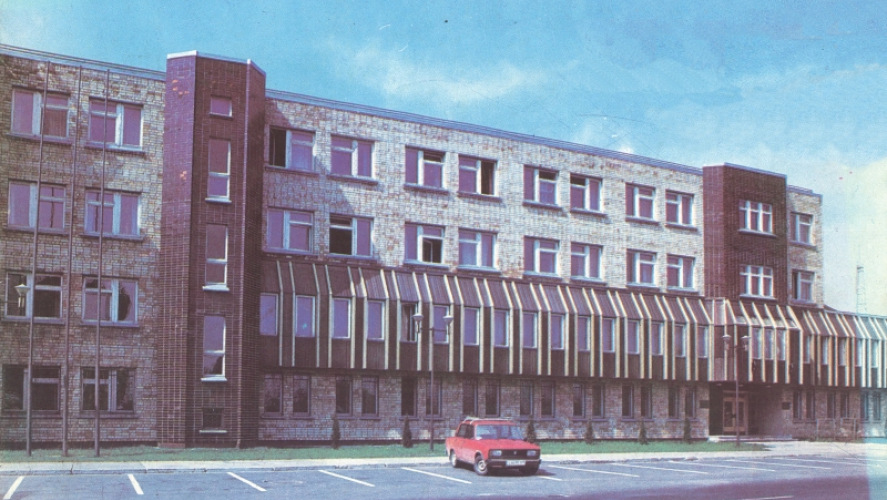 1986New part of the Augstsprieguma tīkls transmission building at Dārzciema iela 86, Riga, commissioned.
1986New part of the Augstsprieguma tīkls transmission building at Dārzciema iela 86, Riga, commissioned.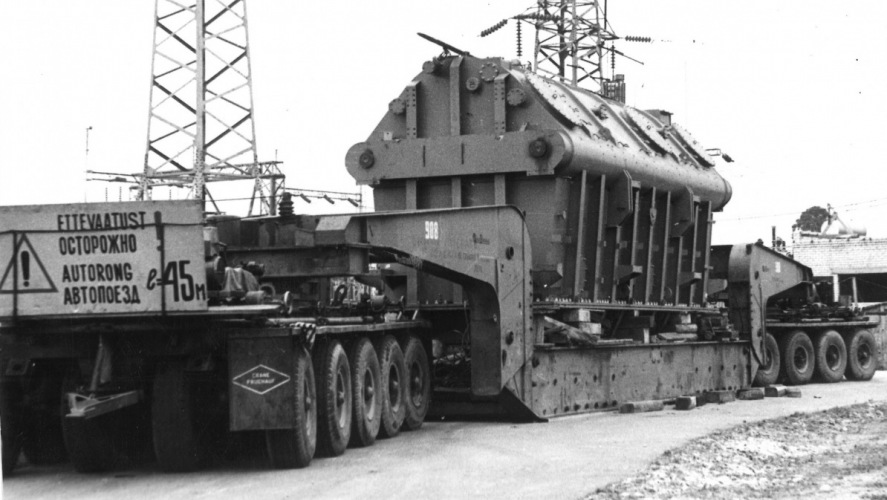 1970 – 1994Construction and commissioning of new substations. Reconstructing of the 110 kV lines from timber to reinforced concrete poles continued, with installation of additional transformers in substations.
1970 – 1994Construction and commissioning of new substations. Reconstructing of the 110 kV lines from timber to reinforced concrete poles continued, with installation of additional transformers in substations. 1960 – 1969All high voltage lines are transferred to 110 kV voltage and norms and tolerances are elaborated for the acceptance of 330 kV lines.
1960 – 1969All high voltage lines are transferred to 110 kV voltage and norms and tolerances are elaborated for the acceptance of 330 kV lines.- 1964Energy system of Belarus connected for parallel operation to the Northwestern energy system union.
- 1963Connection of collective and Soviet farms to the unified power network of Latvia completed. Small power stations cease operation one after another.
- 1961Dispatchers' Authority of the Northwestern Unified Energy System starts operating in Riga. Energy systems of Latvia and Lithuania are connected: Salaspils – Jelgava – Šiauliai.
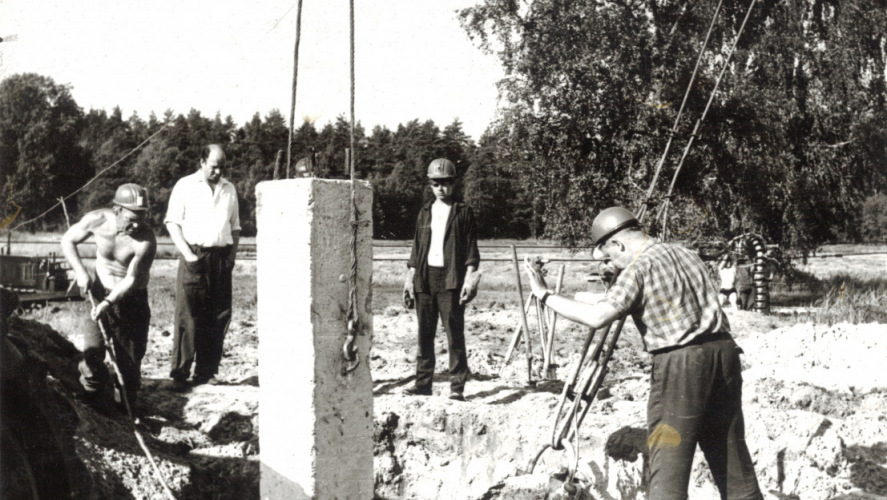 1960Beginning of unified operation of Baltic energy systems. Construction of the first 330 kV power line started from the Baltic SRPP (Estonia) to Riga and Šiauliai, with the distribution in Salaspils. Rearrangement of 88 kV power lines for 110 kV voltage completed.
1960Beginning of unified operation of Baltic energy systems. Construction of the first 330 kV power line started from the Baltic SRPP (Estonia) to Riga and Šiauliai, with the distribution in Salaspils. Rearrangement of 88 kV power lines for 110 kV voltage completed. 1959Augstsprieguma tīkls services 765 km of 110/88 kV lines and 16 substations with 32 transformers with a total capacity of 324.6 MVA.
1959Augstsprieguma tīkls services 765 km of 110/88 kV lines and 16 substations with 32 transformers with a total capacity of 324.6 MVA.- 1956A Line Service and Substation Service established, dealing with the operation and repair of all 110 kV lines in the country.
- 1950Augstsprieguma tīkls manages 88 kV power lines of 408 km and nine substations throughout Latvia.
- 1945 - 1950Power lines destroyed by war are gradually renewed, construction of new substations and lines underway. The level of 1943 is reached in a short time. Rearrangement of networks and substations to 110 kV voltage and development of the high frequency communication system started.
- 1944German Army destroys the majority of Latvian power plants and substations. Practically no electricity supplied to the population. Extensive renovation works started in Ķegums, Andrejsala and on 110 kV lines.
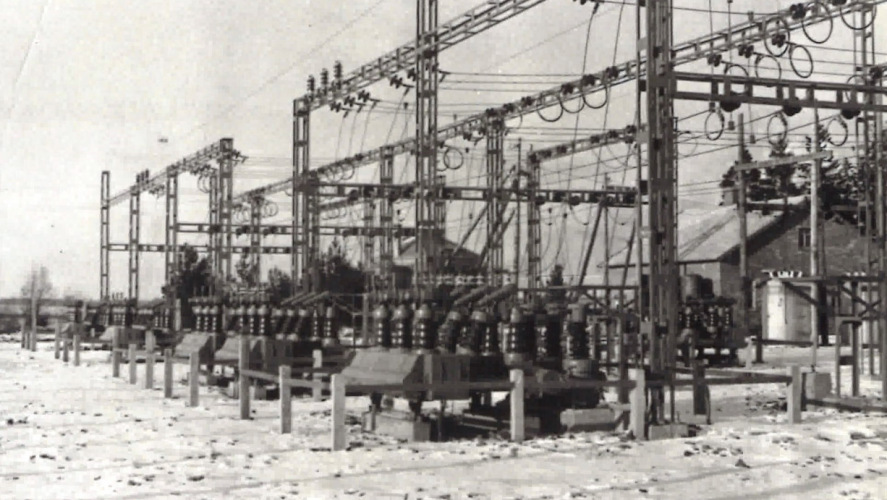 1943Brocēni substation and 88 kV power line Jelgava – Brocēni – Liepāja constructed. Construction of 20 kV power lines Tukums – Kandava, Valmiera – Valka, Aiviekste – Staicele, Aiviekste – Koknese and others underway.
1943Brocēni substation and 88 kV power line Jelgava – Brocēni – Liepāja constructed. Construction of 20 kV power lines Tukums – Kandava, Valmiera – Valka, Aiviekste – Staicele, Aiviekste – Koknese and others underway.- 1941Latvian SSR Local Industry National Commissariat Energy Enterprise Authority Latvenergo formed, but German power establishes the Ostland energy supply company with Latvia general district.
- 1940Of the total amount of electricity produced in Latvia, 77% is produced by Ķegums HPP from renewable resources, water of the Daugava. Approximately six thousand farmsteads electrified.
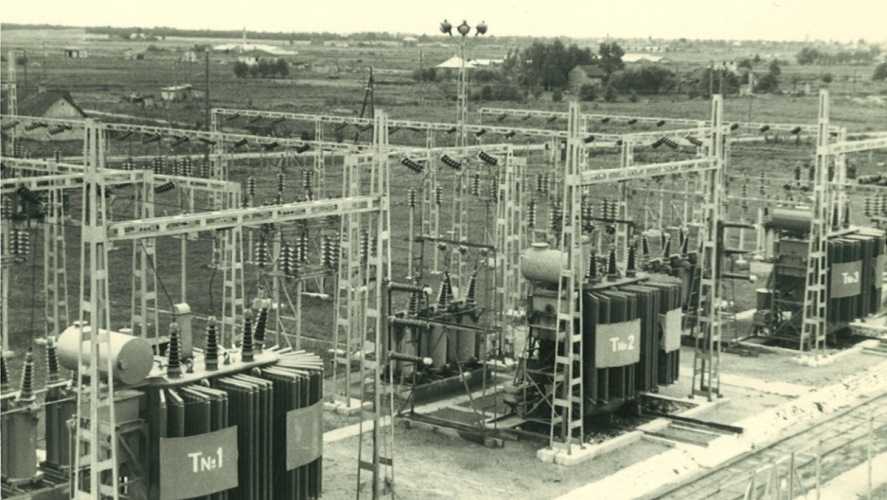 1939Headings of the largest newspapers say: Today the light of Ķegums starts flowing to Riga! On 15 October the Ķegums power plant and the first substation in Riga start operation. At 23:36 residents of Riga received electricity produced by the Ķegums power plant for the first time. This day is considered as the beginning of history of JSC Augstsprieguma tīkls. Birthday of the Latvian energetics' family - 22 December, when the Prime Minister Kārlis Ulmanis as Acting President signed a law regarding the establishment of the State Electricity Company Ķegums.
1939Headings of the largest newspapers say: Today the light of Ķegums starts flowing to Riga! On 15 October the Ķegums power plant and the first substation in Riga start operation. At 23:36 residents of Riga received electricity produced by the Ķegums power plant for the first time. This day is considered as the beginning of history of JSC Augstsprieguma tīkls. Birthday of the Latvian energetics' family - 22 December, when the Prime Minister Kārlis Ulmanis as Acting President signed a law regarding the establishment of the State Electricity Company Ķegums.
